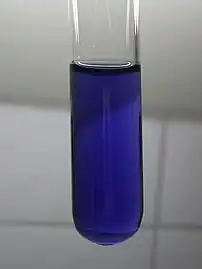 | |
| Names | |
|---|---|
| IUPAC name
Chromium(VI) oxide diperoxide | |
Other names
| |
| Identifiers | |
3D model (JSmol) |
|
PubChem CID |
|
| |
| |
| Properties | |
| CrO(O2)2 | |
| Molar mass | 131.991 g·mol−1 |
| Appearance | Dark blue |
| soluble (decomposes without stabilisers) | |
Except where otherwise noted, data are given for materials in their standard state (at 25 °C [77 °F], 100 kPa).
Infobox references | |
Chromium(VI) oxide peroxide or chromium oxide peroxide or more accurately chromium(VI) oxide diperoxide is an inorganic compound with the chemical formula CrO5 or more accurately CrO(O2)2. It is an unstable dark blue compound. This compound contains one oxo ligand and two peroxo ligands, making a total of five oxygen atoms per chromium atom.
Preparation and properties
Chromium(VI) oxide peroxide is formed by the addition of acidified hydrogen peroxide solutions to solutions of metal chromates or dichromates, such as sodium chromate or potassium dichromate. The generally yellow chromates or orange dichromates turn to dark blue as chromium(VI) oxide peroxide is formed. Chromate or dichromate reacts with hydrogen peroxide and an acid to give chromium peroxide and water.
- CrO2−4 + 2 H2O2 + 2 H+ → CrO(O2)2 + 3 H2O
With this method, the chromium(VI) oxide peroxide will decompose after a few seconds, turning green as chromium(III) compounds are formed.[1]
- 2 CrO(O2)2 + 7 H2O2 + 6 H+ → 2 Cr3+ + 10 H2O + 7 O2
To avoid this decomposition, it is possible to stabilize chromium(VI) oxide peroxide in water-immiscible organic solvents such as diethyl ether, 1-butanol, ethyl acetate or amyl acetate by adding a layer of the organic solvent above the chromate/dichromate solution and shaking during the addition of hydrogen peroxide. In this way, the chromium(VI) oxide peroxide (unstable in the aqueous phase in which it is newly formed) is dissolved in the immiscible organic solvent. In this condition, it can be observed over a much longer period.
CrO(O2)2 is unstable and decomposes on standing to form CrO3. It is incompatible with ketones and primary alcohols, as it oxidizes them to aldehydes and carboxylic acids while being itself reduced to Cr3+. Therefore, CrO(O2)2 is a good oxidizing agent, even better than chromates and dichromates due to the presence of two reactive peroxo ligands, but due to its low stability it is not used in organic syntheses.
Derivatives
The etherate, bis(pyridine) and pyridine complexes of this compound have been found to be effective oxidants in organic chemistry.[2]
The structure of the pyridine complex has been determined crystallographically.[3]
Gallery
 An aqueous solution of chromium peroxide
An aqueous solution of chromium peroxide A very dilute solution of chromium peroxide
A very dilute solution of chromium peroxide_oxide_peroxide_(stabilized_in_ether_phase).jpg.webp) chromium(VI) oxide peroxide stabilized in ether phase (above) and chromium(III) aqueous solution (below).
chromium(VI) oxide peroxide stabilized in ether phase (above) and chromium(III) aqueous solution (below).
See also
- Tetraperoxochromate - an similarly-synthesized analogous chromium(V) peroxide complex
References
- ↑ Holleman, Arnold F.; Wiberg, Egon; Wiberg, Nils; (1985). "Chromium" (in German). Lehrbuch der Anorganischen Chemie (91–100 ed.). Walter de Gruyter. pp. 1081–1095. ISBN 3-11-007511-3."
- ↑ Firouzabadi, H.; Iranpoor, N.; Kiaeezadeh, F.; Toofan, J. (1986). "Chromium(VI) based oxidants-1 Chromium peroxide complexes as versatile, mild, and efficient oxidants in organic synthesis". Tetrahedron. 42: 719. doi:10.1016/S0040-4020(01)87476-7.
- ↑ Stomberg, Rolf (1962). "Crystal Structure of Peroxochromates, CrO5⋅C5H5N". Nature. 196 (4854): 570–571. doi:10.1038/196570b0. S2CID 4187294.
External links
- Experimental details and photo (in German)
- Losing fingers to chemistry on YouTube (8 November 2012). Professor Martyn Poliakoff of the University of Nottingham demonstrates the synthesis on Periodic Videos.
